An SEO competitor analysis is an invaluable SEO tool for determining what your competitors are doing and, most importantly, what’s working for them.
In this guide, you’ll learn how to perform a practical SEO competitor analysis from start to finish.
Follow our checklist to unveil your competitor’s SEO strategies and use them to improve your SEO rankings.
What is the goal of an SEO Competitor Analysis?
SEO competitor analysis helps you find your competitors’ strengths and weaknesses and then use them to improve your SEO.
This strategy can help you reveal new keywords, content ideas, and backlinking tactics you may not have considered before.
There are two ways to look at your business competitors: a rich source of information or mistakes to avoid.
The main goals are to create more relevant content, improve your website’s search engine rankings, and boost organic traffic.
SEO Competitive Analysis Benefits
Here are some benefits your business stands to enjoy from this strategy:
- Identify your business competitors- Winning is hard when you don’t really know who and what you’re up against. A competition analysis helps you identify your real competition.
- Leverage your strengths- Scrutinizing your competition will also help you spot what you do better than them. You can then focus on getting better to gain an edge over them.
- Spot your weaknesses- Similarly, this analysis will help you identify what your competitors are doing and you aren’t.
- Enrich your marketing strategy- An SEO competitive analysis will help you gain insights to improve your digital marketing strategy.
- Understand your audience-Competition analysis will expose you to what your audience loves. For example, you can take advantage of the content ideas you get and concentrate your efforts on that.
SEO Competitor Analysis Checklist
- Define Your Competitors
- Choose Your Competitor Analysis Tools
- Perform a Keyword Analysis
- Analyze Their Backlink Profile
- Assess Content Quality and Strategy
- Examine Their Site Structure
- Find Their Top Performing Pages
- Check Social Signals
- Identify Their EEAT Strengths
- Analyze Their Paid Ads Campaigns
- Examine Their Sales Funnels
- Adjust Your SEO Strategy
1. Define Your Competitors
While defining your competitors may sound rather straightforward, the biggest business in your field isn’t always your biggest competitor.
That said, you need to divide your competitors into two categories:
Direct competitors- These are businesses in the same industry as yours. Their products and services could easily be substitutes for what you offer. Direct competitors may also operate in the same geographical area.
You can find your direct competitors using Semrush’s Organic Research tool.
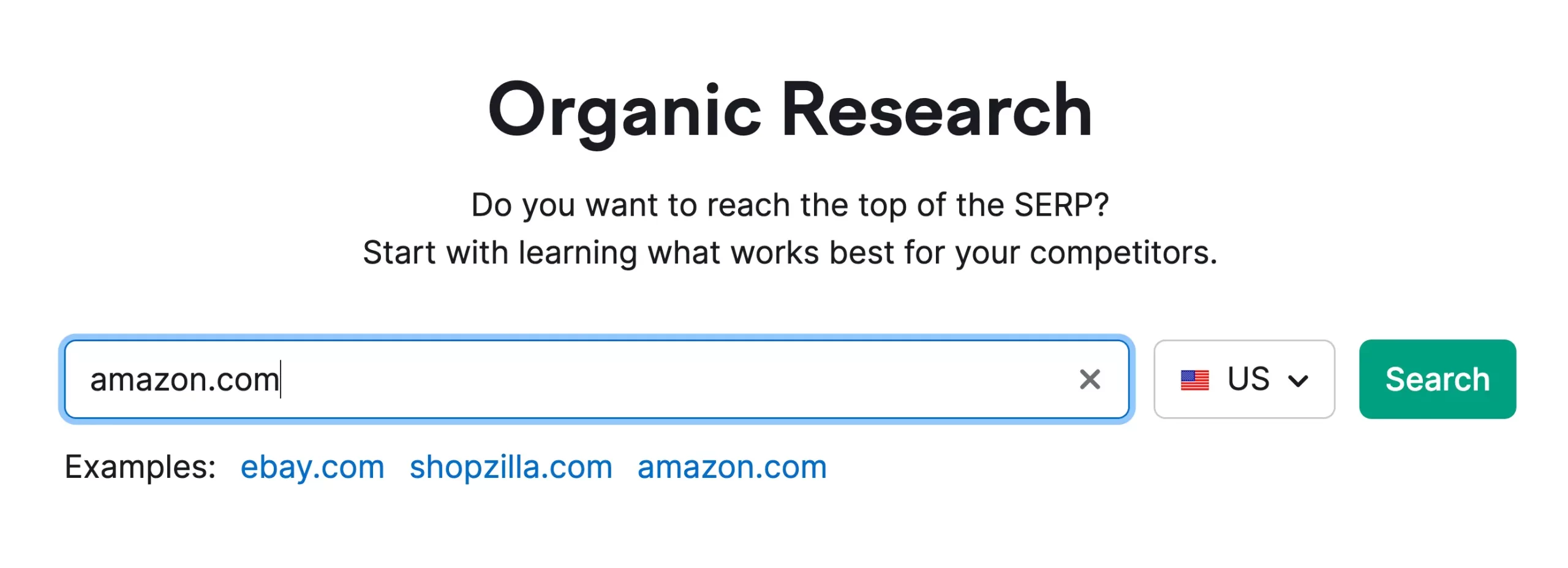
Open the tool, enter any domain, and hit “Search.”
Click the “Competitors” tab and scroll to the “Organic Competitors” section of the report. This will show you the main websites that compete for the same target keyword.
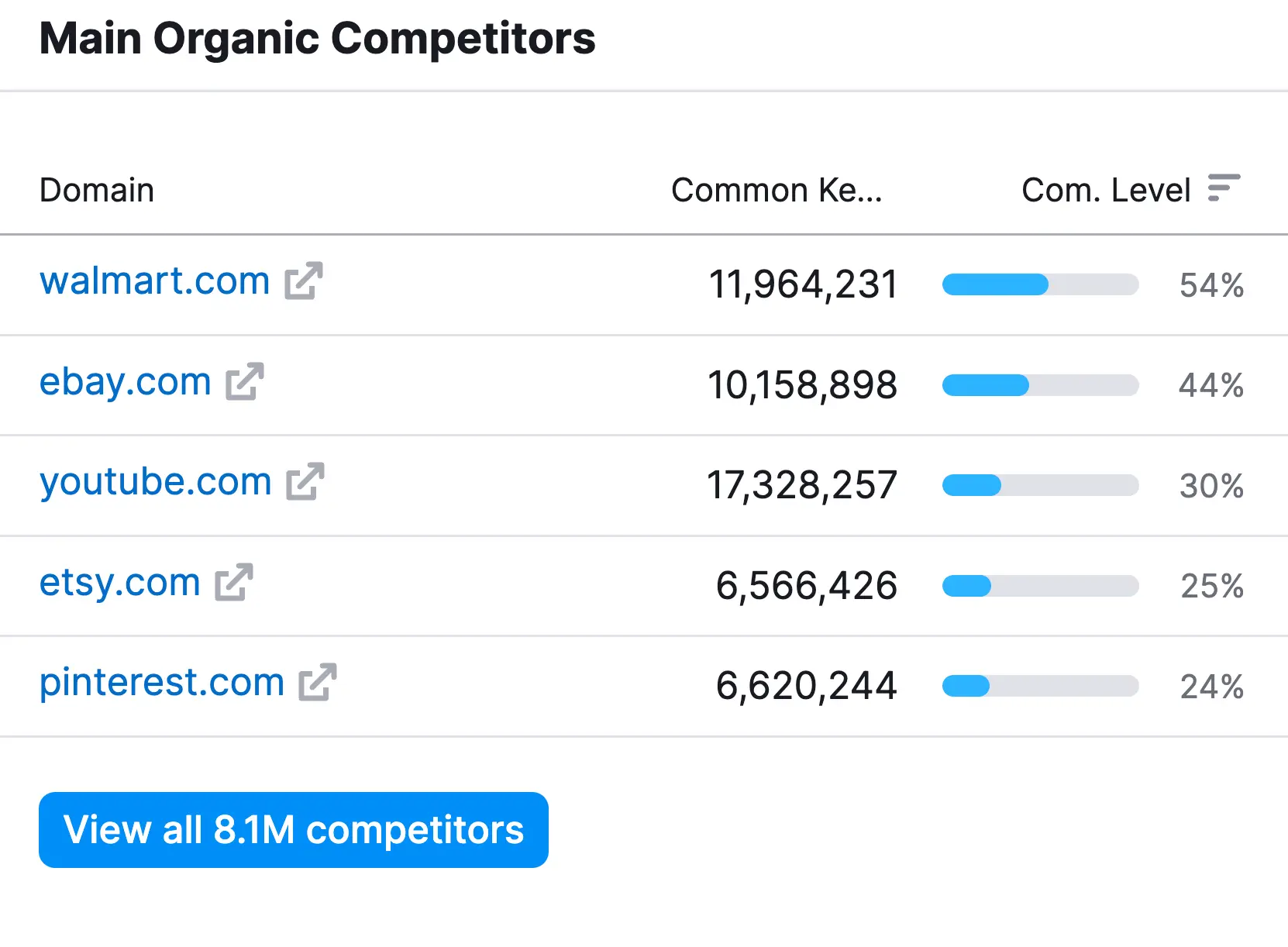
Another way to identify your direct and indirect competitors is to conduct a Google search on your target keywords and see which websites dominate the SERP.
Let’s say you manage a collection of therapy centers in the Midwest. So, “local therapy centers” (with and without a location added at the end of the phrase) is one of your high-value keywords.
If you searched for “local therapy centers,” you’d see something like this:

However, focus on just the top 3-5 sites for any particular search, as your target should be to rank no lower (ideally top 3).
You’ll want to investigate each of these sites to determine whether they are a direct or indirect competitor.
In our example above, the top two listings would be more relevant because they seem to be advertising a network of local therapy centers:

But the bottom listing from Psychology Today? That’s a therapy center directory– content, as opposed to therapy services themselves– so they’re an indirect competitor.
In other words, they’re not offering the same product or service as you.
Keep this in mind as you go, as direct competitors should be weighted more heavily than indirect ones.
2. Choose Your Competitor Analysis Tools
SEO competitor research can be a daunting task. You must analyze keywords, backlinking strategies, content ideas, and site structures.
However, the right SEO tools can make the process significantly easier and faster. Competitive SEO analysis tools are just as important as the analysis itself.
While you might have to pay some fees to use these tools, the value you get from them justifies the investment. Many business owners eventually find that the tools technically pay for themselves.
For most SEO professionals, the primary SEO tool of choice is either SEMrush or Ahrefs.
SEMrush is an all-purpose SEO tool that can serve virtually your every purpose.

Some tools can do certain things better, but there’s essentially nothing that SEMrush (or Ahrefs) cannot do well.
SEMrush shines when it comes to reporting volume and access to more data in general. That’s because SEMrush’s database is much larger than Ahrefs, meaning it provides more reliable data.
Ahrefs excels when it comes to backlink reporting tools, making it arguably the best for tracking backlinks, even compared to SEMrush.

It also has more detailed data from non-Google platforms when compared to SEMrush, such as Bing, YouTube and Amazon.
Other SEO tools you can consider are:
Ubersuggest is similar to SEMrush and Ahrefs, though with a smaller database and a much more limited set of features. For that reason, you can’t depend on it as your sole SEO tool.
Keyword Planner, an official tool offered through the Google Ads platform, has a unique value in that the data comes straight from the source.
Without a running Google Ads campaign with enough ad spend, however, you’ll only be able to view high-level ballpark numbers that aren’t much use.
3. Perform a Keyword Analysis
To perform a proper keyword analysis, you’ll want to gather a few important pieces of information:
- Targeted Keywords: What keywords are your competitors focusing on?
- Keyword Gaps: What keywords are they ranking for that you aren’t?
- Keyword Overlaps: What keywords are you both competing for?
Targeted Keywords
To find what keywords your competitors are targeting (and which are their top performers), run an organic search results report for each of your competitors and look for patterns in the types of keywords they’re targeting.
In the example below, you can see that the site is finding success targeting similar “near me” keywords:

By studying what keywords your competitors are targeting, you can identify what’s likely working best for them so that you can replicate those results.
Keyword Gaps
Head to the “Keyword Gap” report in SEMrush and input your site as well as your competitors:
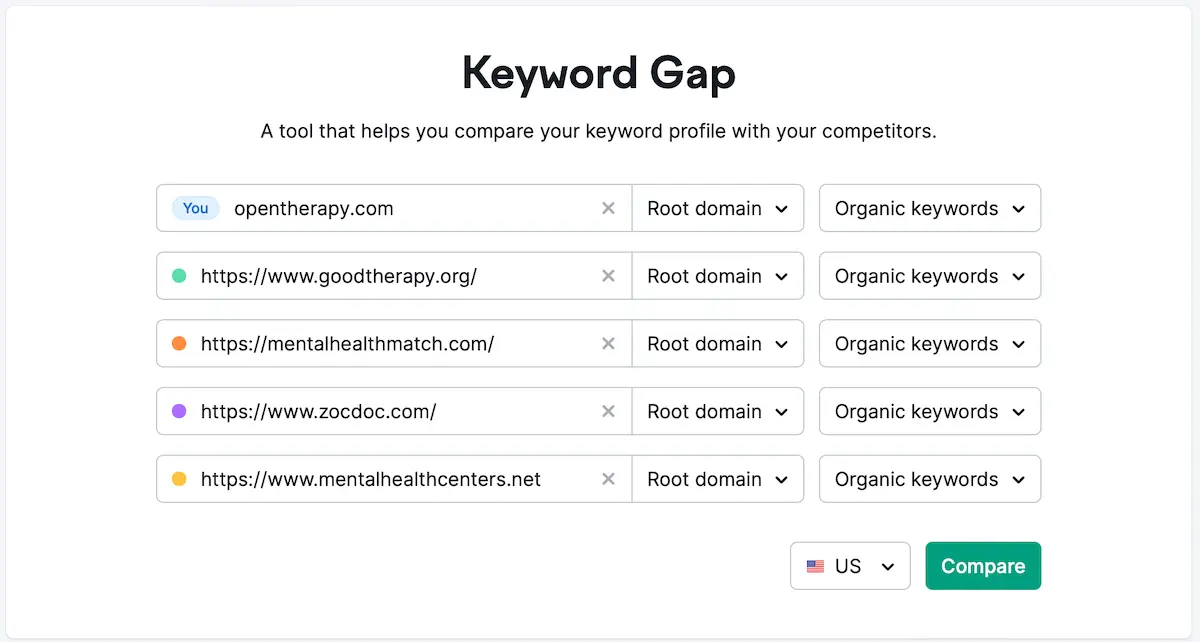
You’ll see a detailed comparison of which pages your competitors rank for that you don’t, allowing you to identify untapped opportunities:

Keyword Overlaps
From the same “Keyword Gap” menu in SEMrush, simply select “Shared” from the report menu:

From there, you’ll want to look for pages where your competitor ranks higher than you (page 1 only, preferably rank 1-3).
These are great opportunities because they’re pages you already have content for that may simply need to be refreshed to boost their ranking.
By organizing the report based on your competitor’s highest-ranking pages, you can easily identify your own pages that could use improvement:
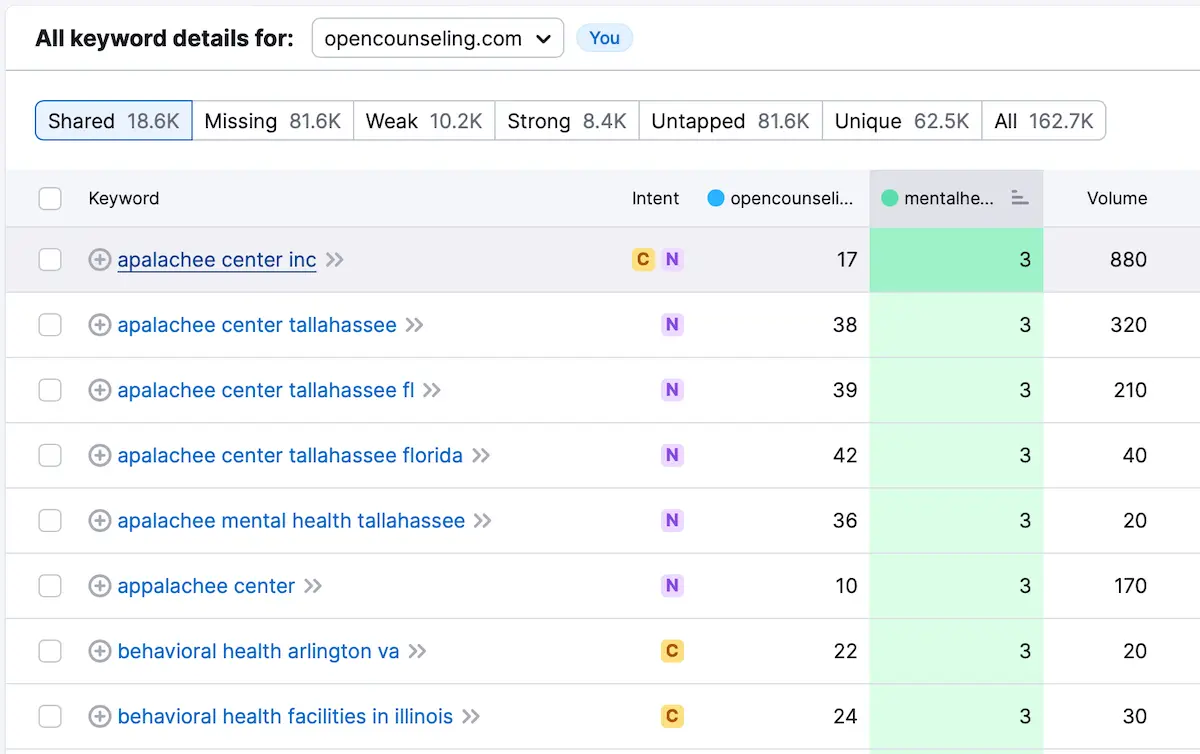
4. Analyze Their Backlink Profile
To analyze your competitor's backlinks, you’ll want to gather:
- Total Backlinks: Quality and quantity.
- Referring Domains: How many unique domains are linking to them?
- Anchor Text Distribution: See if they're optimized for specific terms.
To find your competitor’s backlink data with SEMrush:
- Go to the “Link Building” section
- Then “Backlink Analytics”
- And type in your competitor:
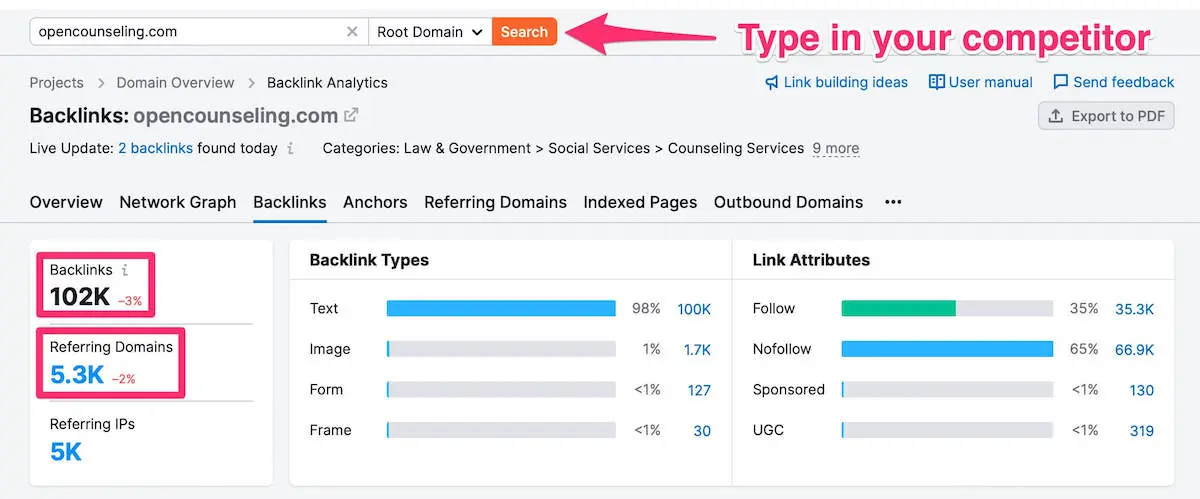
You’ll now be able to see high-level information regarding your competitor’s backlinks, but you can click through further to see things like:
- Who exactly is linking to them?
- And what is the average quality of their backlink?
Click on “Referring Domains” and you can see what sites are linking to your competitor as well as that link’s “Authority Score”, a grade that estimates the quality of the backlink (100 best, 0 worst):
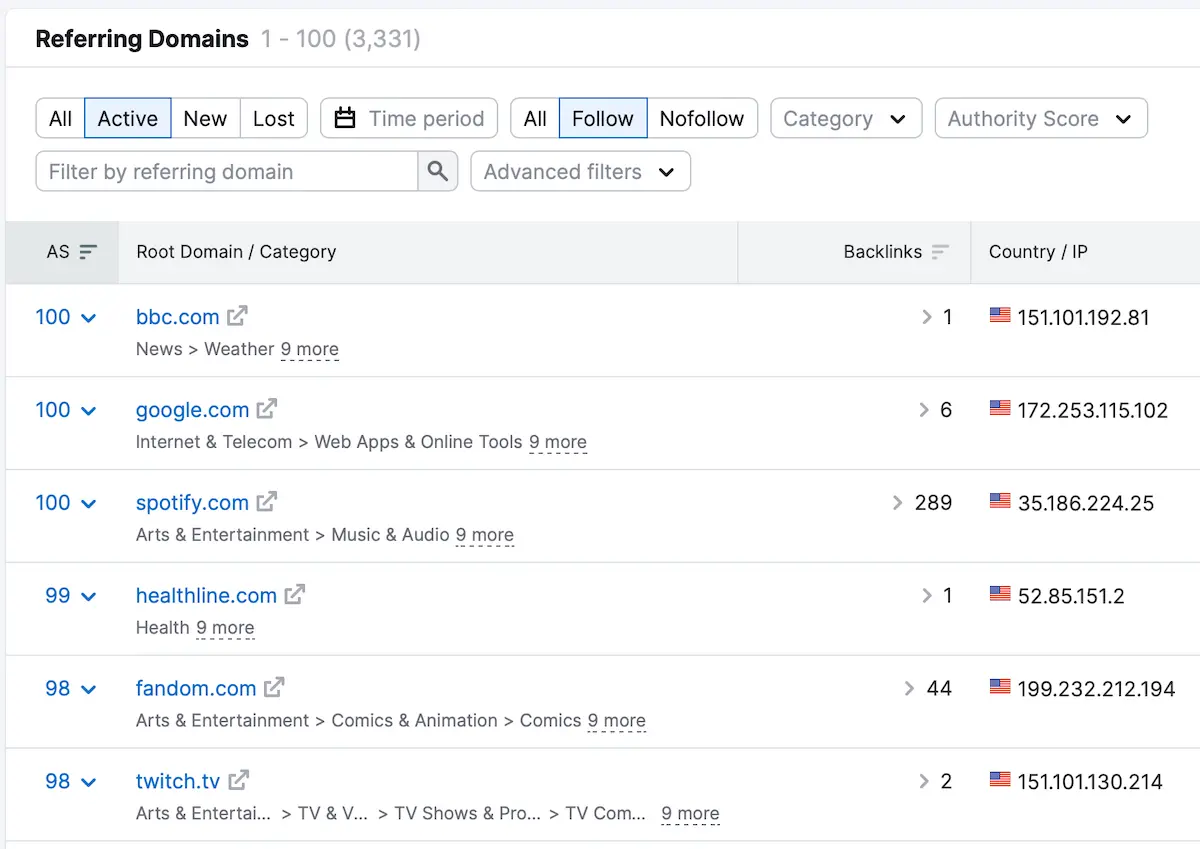
And if you click on “Anchors” you can see the anchor text distribution for your competitor:
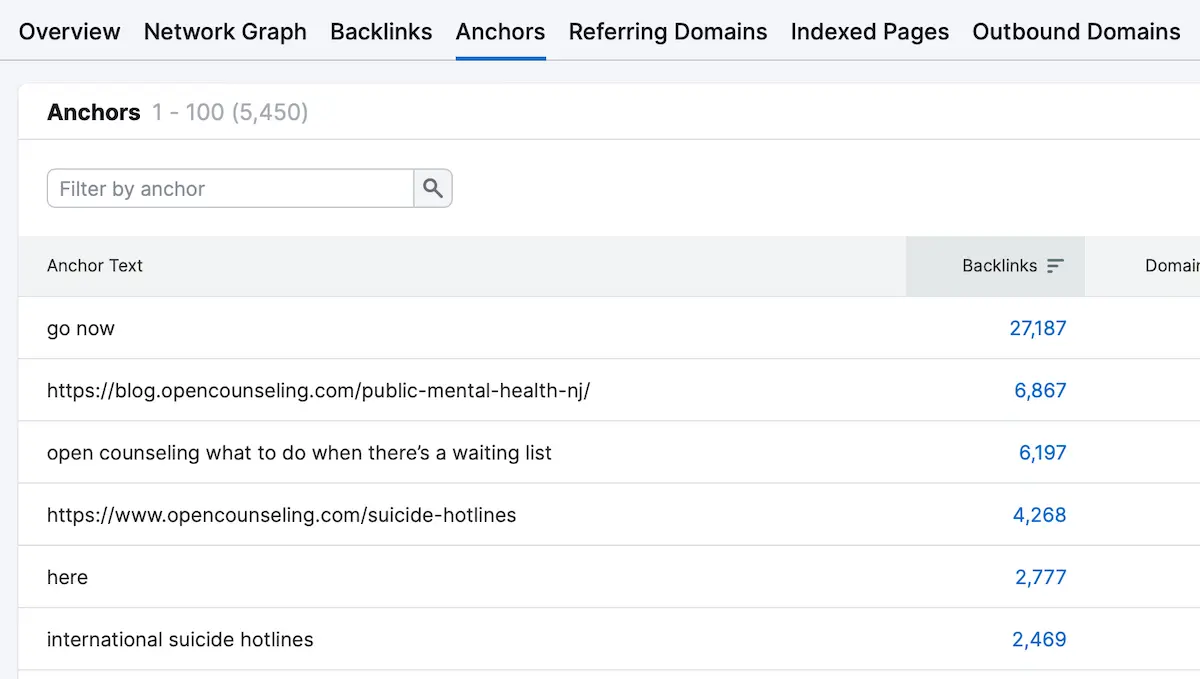
This gives you insight into whether your competitor’s anchor text is optimized for any specific terms influencing their performance.
5. Assess Content Quality and Strategy
Take a look at your competitors’ content strategy and the quality of the content they publish.
First, determine the content types they’re putting out. The content types could include:
- Ebooks
- Podcasts
- Blog posts
- Infographics
- Case studies
- White papers
- Youtube videos
Next, look at the publication frequency of their content assets.
Do they publish new blog posts every week or every month? How often do they publish a new ebook or case study?
If your competitor has a robust content strategy, chances are that they’ve been publishing regularly. Based on their topics, analyzing their content will help you understand their lead-generation strategies.
After that, look at their content quality. At the end of the day, if quality is lacking, their posting frequency won’t matter since their audience won’t value the content.
To make the process manageable, select a few pieces of content to analyze instead of looking at every piece individually.
A wide variety of topics will also help you get a bigger picture of what your competitors share with your audience.
Here are some questions to ask yourself when analyzing your competitor’s content:
- What tone do they use?
- Is their content accurate?
- Are their articles bylined?
- Is their content grammatically correct?
- Is their content in-depth? (beginner or expert level)
- Is their content freely available or is their audience required to subscribe?
- Is their content well-structured to boost readability (headings, numbered lists, and bullet points)
- Who writes their content (Freelance writers? In-house content team? Multiple contributors?)
Lastly, analyze the impressions every type of content gets to see whether there are any gaps to take advantage of.
For example, if your competitor publishes YouTube videos regularly but only gets a handful of views, they’re probably not optimizing their channel.
You could take advantage of this and publish high-quality, relevant, and optimized videos on your business’ Youtube channel.
If Google is showing video results for your target keyword, your videos could appear on search results and boost your views and site authority.
6. Examine Their Site Structure
Website structure is important for both search engines and users. A simple and clean site structure improves user experience and crawler rating.
Looking at your competitor’s website structure will help you understand how their main pages are categorized and where most of their search traffic goes.
Here are some questions to guide you when examining their site structure:
- Are their URLs short and descriptive?
- Do the URLs include the target keywords?
- How and where do they use their internal links?
The goal is to spot anything your competitors are doing and you’re not. Use your competition as the benchmark to improve your URLs.
7. Find Their Top Performing Pages
Examine pages from your competitor’s website that outrank you. Conduct an in-depth analysis of the type of content the pages have.
First, understand whether their top-performing pages have a particular format- whether landing pages, blogs, or video content.
After that, answer the following questions:
- What topics do they cover?
- Are the topics covered in detail?
- How high-quality is the content?
- How have they placed keywords?
- Is their readability score higher or lower than yours?
- Do they have any relevant secondary keywords that you could use in your content?
Analyzing your competitors’ pages to see what they’re ranking for is a great opportunity for you to gain an edge over them.
For example, many brands are still lagging behind in video content even though video results now occupy most Google listings (and get more engagement):
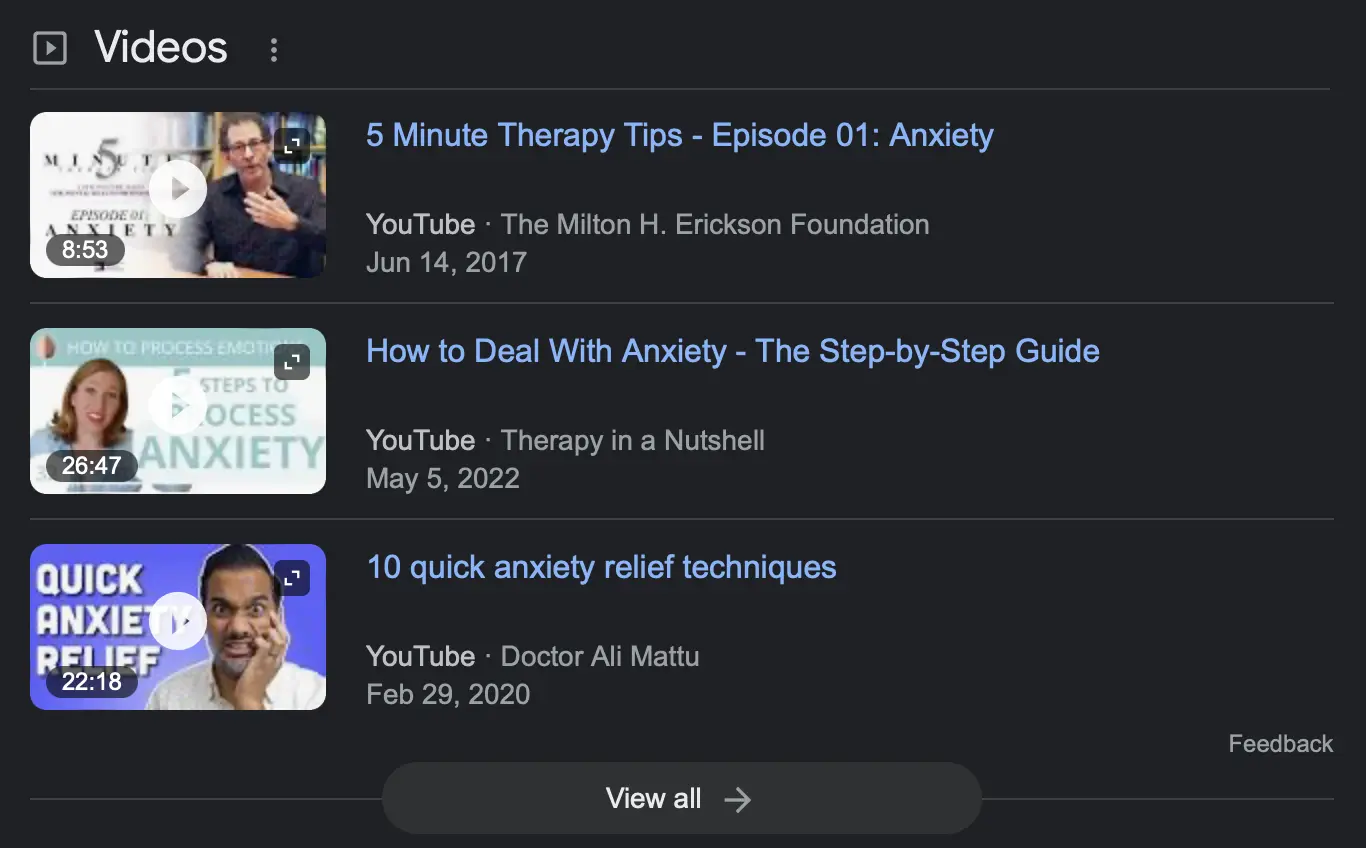
Producing high-quality video content could be a way to fill a niche your competitors aren’t filling and give you an immediate leg up in the SERPs.
The only way to find out if that’s the case, however, is by studying what your competitor’s top pages and content are.
8. Check Social Signals
Look at your competitors’ social media presence and engagement rate.
This analysis will help you establish how your competitors drive engagement for their brands through social media.
Start by checking whether they have any social media sharing buttons on their blog posts. Also, look out for any social media channels on their headers, footers, or anywhere else.
If you find them using any platforms that you’re not on, you might want to learn more about how that platform can help your business. Look at their engagements on the platform to confirm whether it’s worth your time.
After that, use the following metrics to measure your competitors’ social signals:
- Posting frequency
- Number of followers
- Content virality (number of shares or retweets)
- Post engagement (number of likes and comments)
Analyze your competitor’s social media strategy with the same gravity you do their content marketing strategy.
Also, pay keen attention to the kind of content they’re posting.
Are they posting more educational videos to increase engagement and brand awareness? Or is their focus more on driving their audience to their landing pages to increase sales?
Don’t forget to check how they interact with followers who engage with their posts.
A tool like SproutSocial is perfect for getting this information quickly. You can run reports on shares, impressions, and total engagement for each platform:
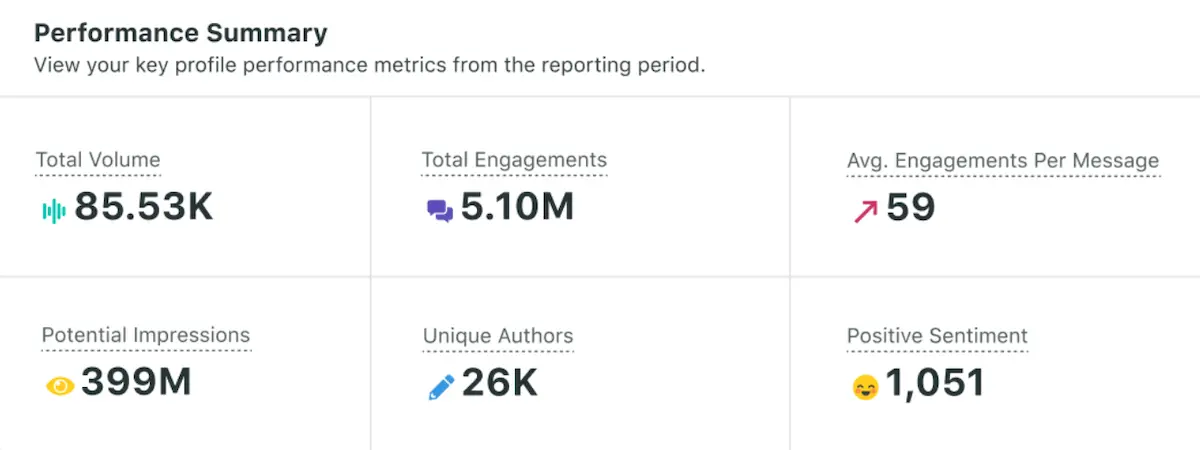
Under “Cross Channels” -> “Group Report” you can also generate graphs that serve as a perfect visual reference to see how much of your competitor’s voice each social channel occupies.
9. Identify Their EEAT Strengths
Google’s EEAT – or Experience, Expertise, Authoritativeness, and Trustworthiness– is an important part of modern SEO, and it’s all about displaying authority and reliability in your subject matter.

First, check these items to see how effectively your competitors are sending each of these “signals” to Google:
- Author Profiles: Are authors showcased? What are their credentials?
- Content References: Are they citing authoritative sources?
- Onsite Reviews and Testimonials: What are users saying about them on their site?
- Trust Signals: Do they have any industry certifications, awards, or affiliations?
Once you’ve done that, identify holes or weaknesses in your competitor’s content that will allow you to make your content more in line with EEAT than theirs.
Also, if they’re doing a good job in a certain area, note how they’re accomplishing it so that you can utilize the same or a similar strategy.
10. Analyze Their Paid Ads Campaigns
Most people consider organic and paid results two different entities.
However, analyzing your competitors' Google and social media ads can help you identify valuable and profitable keywords.
If your competitors are willing to bid and pay to appear on search results for a certain keyword, chances are that the keyword is valuable and drives traffic.
Also, sometimes you’ve done everything to boost your SEO, but your competitors still beat you on search results.
In this case, your competitors are probably outbidding you and using paid ads to generate traffic and conversions.
Ask these questions when analyzing their paid ads campaigns:
- What visuals do they use in their ads?
- What is the messaging of their ad copy?
- What landing pages are their ads directing users?
To find your competitor’s paid campaigns using SEMrush, Go to Domain Overview and enter your competitor’s name and Scroll down to ‘Top Paid Keywords’ and click to view details:

Click ‘Advanced Filters’ right above ‘Traffic Cost’ and exclude brand keywords.

From here, you can see how much they spent on ads, the keywords they bid on, and the landing page their ads are directing users to.
Next, to view those ads and get an idea of the ad copy, messaging, visuals, and CTAs used, you can go to either the Google Ads library or Facebook Ads library:
Head to the Google Ads library and type in your competitor's domain name. You’ll see a collection of that competitor’s ads in every format they posted them in, along with the copy and any visuals used:
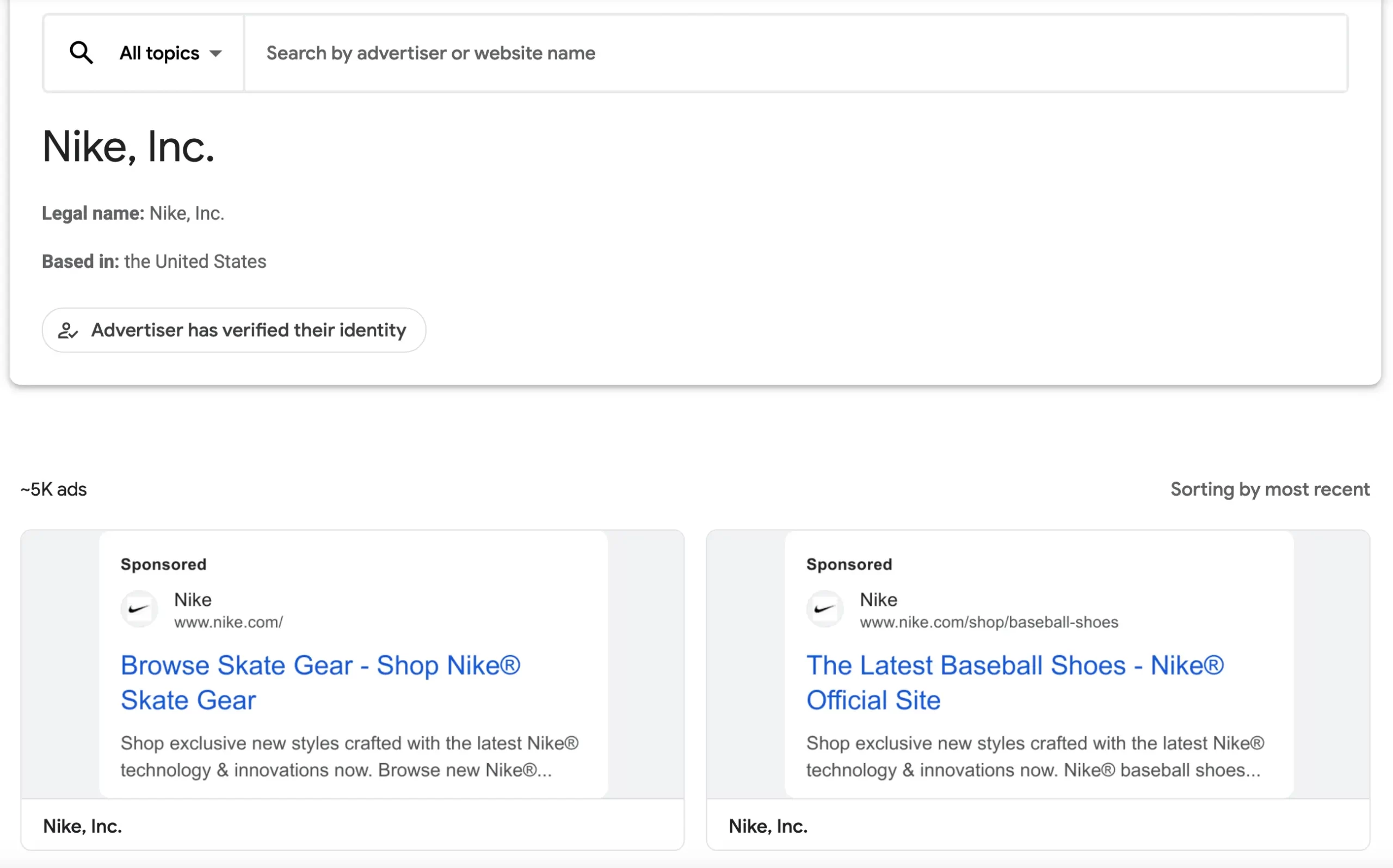
Studying your competitor’s ads can allow you to figure out what’s working for them on the paid ad side and uncover new and valuable keywords that you can rank organically for.
11. Examine Their Sales Funnels
You must also analyze their sales funnels and see their sales process.
This process can be a bit tricky.
But these questions should guide you through the process:
- What channels do they use to sell?
- Do they provide any offers to entice their users?
- What steps do users take from landing pages to conversion?
- What content do they use to attract their users into the funnel?
- Where do they ask their users to convert (subscribe, purchase)?
- Do they have ads or email marketing strategies to bring back potential leads?
Once you answer these questions, the information you get will give you an idea of what their sales process is like and how competitive it is.
You might also have to do some detective work yourself. Sign up for your competitor’s newsletter, visit their landing pages, or subscribe to their free trials.
By putting yourself in your customers’ shoes, you’ll gain deeper insight into your competition’s sales funnels and processes.
12. Adjust Your SEO Strategy
Now, it's time to put your insights into action.
Based on the data, refine your SEO strategy to leverage strengths, address weaknesses, and tap into new opportunities.
You can start by creating optimized content based on your findings.
What major content gaps did you discover on your competitor’s website? What content type seems to be bringing them more results? What target and secondary keywords did you find on their top-performing pages?
Conclusion
Depending on your number of active SEO competitors, you’ll need to carry out this process every 6 to 12 months.
Remember, SEO is constantly changing. Continuously monitoring your competitors’ SEO strategies, monitoring SERP rankings, and constantly tweaking your strategy will help you remain competitive.
It can also save you an enormous amount of money by taking advantage of the lessons your competitors have already learned (and paid for) and replicating them.
It also helps you uncover mistakes you’re making so that you can perform adjustments and generate better results.
Use the tips and tools in this guide to conduct an effective competitor analysis and level up your SEO.



